2023
August
31
|
Hurricane Idalia hits Valdosta
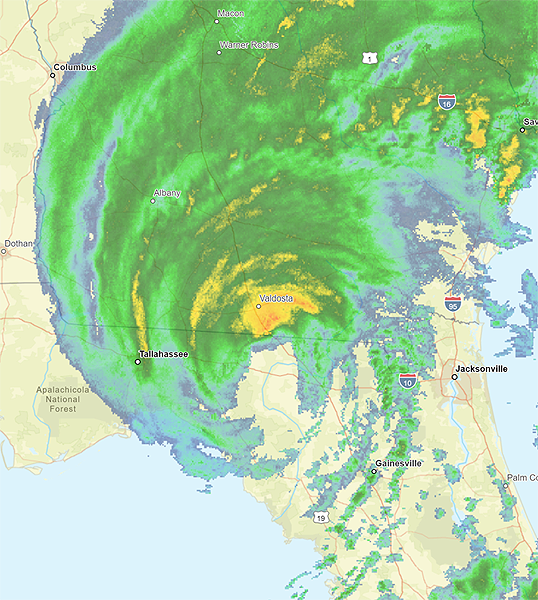
NOAA radar
Yesterday morning, Hurricane Idalia passed directly over my home town, Valdosta, Georgia,
moving northeastward from the Gulf. I was safe and dry in Athens, over two hundred miles to the north,
but followed the disaster with great concern. A friend who did not want to be named
contributed two pictures that show what happened:


From what I can find out, that, basically, is what happened all over town —
tall pine trees fell and took down power lines or blocked roads.
The area is still largely without electricity, and we are hearing surprisingly little about
other damage. There is an unconfirmed rumor that the hospital had trouble with its backup
electric generators the first night and had to ration use of electricity.
One fatality has been reported — someone was clearing a tree when another tree fell
on him.
Those are the few things I've found out.
My sister and many friends are definitely OK, but are having to ride out a 3-day-or-so
power outage; I have not heard much about people seriously harmed, but they are inherently
the ones we won't hear about yet. Pray for Valdosta.
Permanent link to this entry


|
2023
August
21
|
This, too, has been called IC 1318
Northern wing of the "Butterfly Nebula" in Cygnus

If you scroll down to my wide-field view of the nebulae around Gamma Cygni, you'll
see, left of center, two bright nebulae that look like the wings of a butterfly, somewhat
separated. This is the northerly of those two wings.
They, too, go by the name IC 1318 and are called the Butterfly Nebula
(as is another quite different nebula elsewhere).
This picture is something of an extravaganza because it is a stack of 70 (yes, 70)
successive 2-minute exposures. All the more daring is the fact that I simply told
PixInsight to stack all 70, even though I knew some of them were poorly guided.
Because the vast majority were well guided, the outlier-rejection algorithm simply
rejected any data that contradicted them, and we got a good picture.
The guiding was not perfect, for two reasons. There were mechanical bumps or jerks
occasionally, probably from cables sliding across each other and occasionally catching.
And there was some elongation in a mostly (not perfectly) east-west direction apparently
due to differential flexure, so that when the guiding software reported excellent
tracking, the actual pictures were not quite that good. This is something I will
troubleshoot. The guiding imperfections are completely invisible in the picture
you see here, which was downsampled about 4×. We aren't going to make a
wall poster out of it anyhow (or if we do, we'll keep it downsampled!).
Celestron 8 EdgeHD, f/7 reducer, Losmandy GM811G mount, 60×240 guidescope and
ASI120MM guide camera, in my driveway in Athens, Georgia. All controlled with a
ThinkPad T490s running PHD2 and N.I.N.A.
Permanent link to this entry


|
2023
August
20
(Extra)
|
NGC 6888
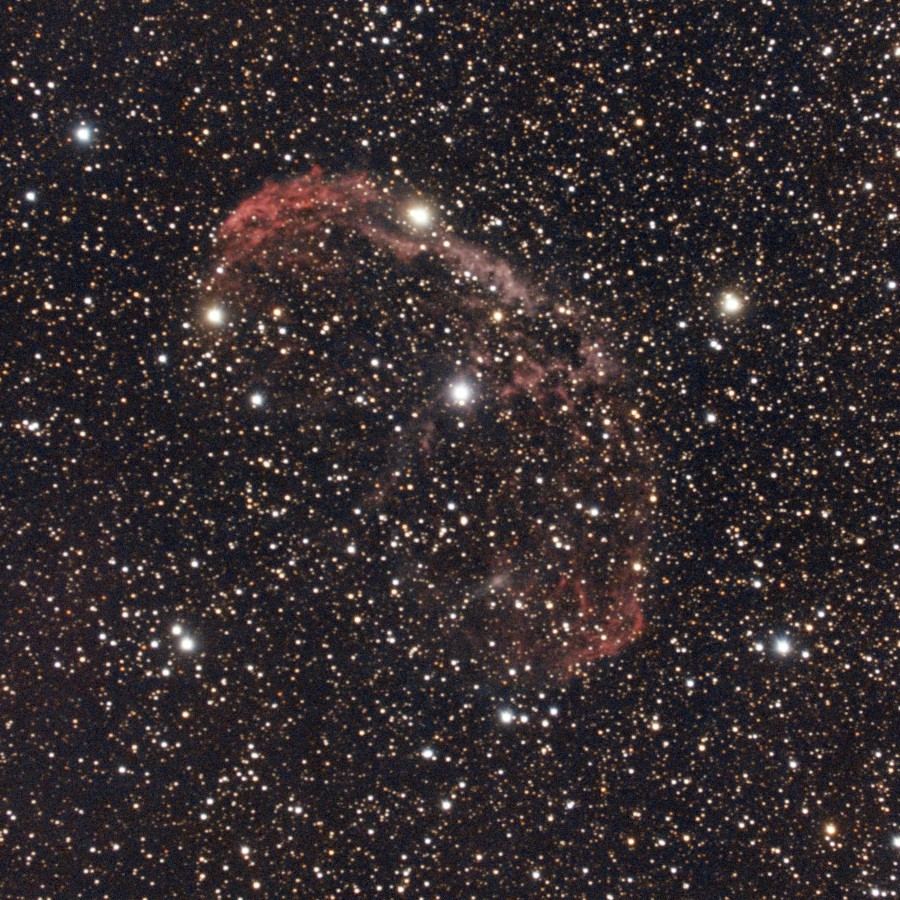
I've photographed NGC 6888 (the Crescent nebula)
before, but this is the first time I've combined results
from two different sessions. This is a stack of 50 2-minute exposures,
25 each from sessions on August 16 and 18.
We are finally having a series of clear nights that are giving me the
opportunity to familiarize myself with new equipment and software and fine-tune
things in a way that wouldn't be possible if each session were days or weeks away
from the others.
(Yes, a Losmandy GM811G mount is "new equipment" although I've had it for a year.
It takes dozens of observing sessions, and hence several years, for me to really
settle into a piece of equipment.)
Celestron 8 EdgeHD, f/7 reducer, Canon 60Da, Losmandy GM811G mount (in my driveway
in Athens, Georgia), guidescope and guide camera, controlled with PHD2 and N.I.N.A. software.
Permanent link to this entry
Is this IC 1318? If not, what is it?
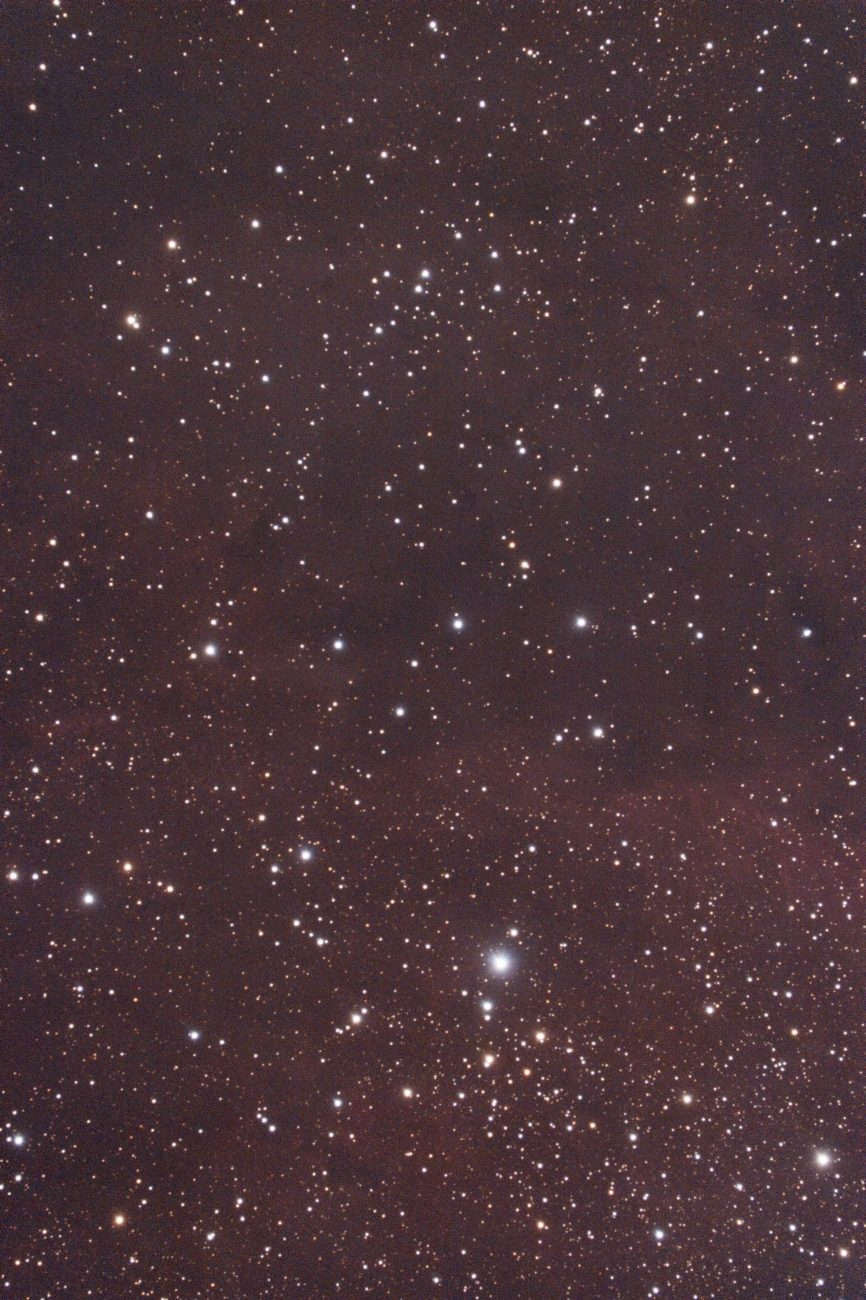
This is what I got when I told N.I.N.A. to photograph IC 1318, which I took to be a
nebula in the region of Gamma Cygni (Sadr). But N.I.N.A. did not point the telescope
where most star atlases plot IC 1318, a bit northwest of Gamma Cygni. Instead, it chose
a region a couple of degrees south of there. What's going on?
As you can see, there is nebulosity in the picture, although this does not look
like a noteworthy bright spot that would be listed in catalogues.
I think N.I.N.A. made a mistake. Using Simbad, the standard online reference, I found IC 1318
at the position shown by Stellarium and other star atlases, and at the position that N.I.N.A. used,
I found the coordinates for LBN 234, a large irregular region. I thought N.I.N.A. simply used
the wrong object.
But the truth is more complicated. The Index Catalogue (IC, by Dreyer, 1895) does not give the
(apparent) sizes of objects; that is, it doesn't say how much sky they cover.
It tells us that IC 1318 was discovered by Barnard (the pioneer astrophotographer) as
Gamma Cygni surrounded by a large region of faint nebulosity.
Apparently, Barnard's object, listed as IC 1318, was intended to comprise
virtually all the red nebulosity in
the wide-field
picture of the Gamma Cygni region that I took last year,
reproduced here:

The position normally given for IC 1318 nowadays corresponds to the bright patch near
the upper right corner of the picture, and that's where I thought I was heading.
But N.I.N.A. took me to an area in the lower right part of the picture, chosen for
obscure reasons as the coordinates of LBN 234, which is apparently also intended to comprise
all these nebulae.
The brightest and most interesting patches are those to the left of the center;
they are also sometimes called IC 1318 and are one of the two celestial objects known
as the Butterfly Nebula (see the two wings; the other Butterfly Nebula is a compact
planetary nebula elsewhere). I shall photograph them and lament that they don't have
clearer designations.
Permanent link to this entry


|
2023
August
20
|
The trip to Australia
The year 1973 was perhaps the single most formative year of my life, so we have recently
passed the 50th anniversaries of many important events. Here is one of the most important.
I have had many unexpected opportunities and blessings to be thankful for,
and one of them is the trip to Australia.
Technically, it all started in the fall of 1970, when my high school invited
me to take the PSAT (Preliminary Scholastic Aptitude Test) even though I was in ninth
grade rather than tenth.
Though I didn't realize it, that put me on the track to finish high school in three years
and get a National Merit Scholarship at the right time.
So far, that's straightforward.
As part of the PSAT process I was asked to describe myself, and since I thought this was
just a first try, I wrote a short essay about my very broad interests and my concern for
ultimate values, not just amassing knowledge. Almost as soon as I wrote it, I thought it
would come across as priggish.
But the surprise was that in the spring of 1973, my school and I got letters from
the National Merit Scholarship Corporation asking if I was available to travel for a month
in August and September and if I would like to be interviewed for a science school
in Australia.
I wrote back that I would be delighted, and things were set in motion.
I was sent to Valdosta State College for an interview, then to Washington in mid-summer
for orientation.
Apparently they had liked my strange essay, because the press release said a lot about
how I had exceptionally broad interests. (Which was and is true. I was the same
character at 15 that I am today.)
Fifty years ago today, August 20, 1973, I got on a plane in Valdosta, joined
the rest of the crew in San Francisco, went to Hawaii, Australia, Thailand, India, and Italy,
and flew back to Georgia. Meanwhile my heroic mother and sister moved from Valdosta to
Athens, Georgia, into a new house of very similar design, and I came home to find my
bedroom very much as I had left it, but 200 miles to the north! We students said our
farewells in New York on September 18, and the next day I started classes at the University of Georgia.
What we attended is now known as the Messel Science School at the University of Sydney.
Since the mid-1960s, and until at least 1974, the United States sent a group of students
every year and also gave them a world tour. I think we were intended to be goodwill ambassadors
of some sort, but in fact we met almost no one in the countries other than Australia, and it
was basically educational travel. It happens that 1973 was a great year for the International
Science School (as it was then called) because the topic was astrophysics and the International
Astronomical Union was meeting in Sydney at the same time. Accordingly, we had very
distinguished lecturers (Bok, Sagan, Hanbury Brown, Burbidge) and I very much regret being too
shy to seek them out so that I could tell my grandchildren I had met them personally.
It was a transformative time for me; it may be the first time in my life I had been among people
with first-rate intellects who were highly congenial (unlike GHP, there was absolutely
no rivalry between us); and it was, in an important sense, the beginning of my adult life.
Here, now, are a few pictures to bring back memories.
Press photo of the group:

The full itinerary:

My last moment as a Valdostan:

On the plane:
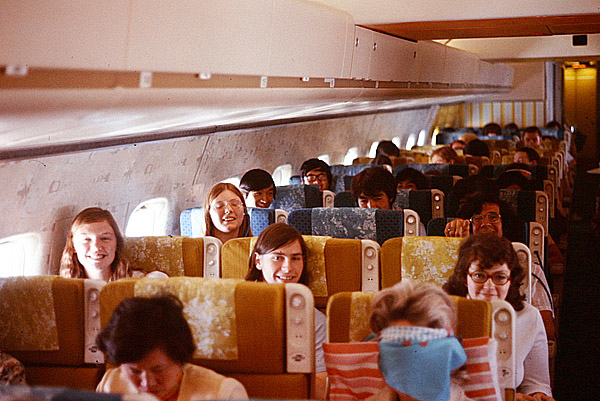
Kilauea volcano, Hawaii:

Sydney (from the top of Australia Square):

Our classroom at the School of Physics, University of Sydney
(yes, the school was on national TV in Australia):

Wat Phu Khao Thong, Ayutthaya, Thailand:
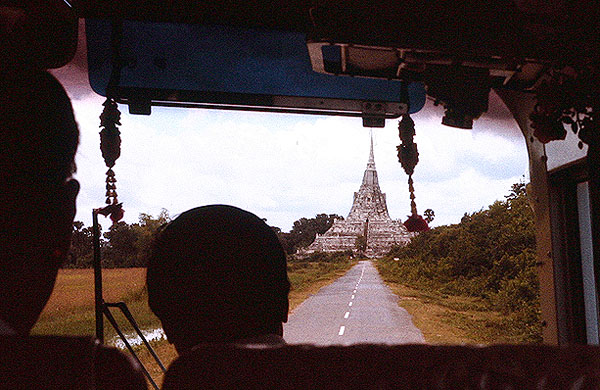
Some levity in Agra, India (you may recognize the building):

Rome:

And then home. I had been planning to double-major in astronomy and ancient languages
at UGA, but during the summer of 1973 it became clear that my main scientific interest
was not astronomy but computers, so I didn't study astronomy academically, majored
in ancient languages and quickly changed to linguistics, and pursued computing outside
the classroom for several years. In retrospect I wish I had made more of the Science School;
if I had been planning to go into astronomy it could have given my career a powerful start.
But that was not my path, and during the world tour, my attention was almost entirely on
world culture, history, and languages, not the science we were going to study in Sydney.
Permanent link to this entry


|
2023
August
11
|
What is Hawaii?
It makes me sad when a building I've been in is torn down.
But what about when a whole town is wiped out by a wildfire?
That's what has happened to Lahaina, Maui, Hawaii, whose shopping
mall I walked around in some time in the late 1990s.
The tragedy in Hawaii is immense, and we do not yet know its extent.
CNN has a good opinion piece
by a native Hawaiian pointing out that Hawaii is not a tropical paradise,
but rather a challenging environment.
It complements a thought that I, as an outside visitor, have often had.
I've been to Hawaii 3 times (the first almost exactly 50 years ago).
The more I looked at it, the more I came to see it as a very artificial product of marketing.
Of course, there are good reasons to be in Hawaii.
Maybe you're a native.
Maybe you're involved in the islands' unique agriculture and the businesses that support it.
Maybe you're there because it's a very useful place for ships and planes to stop while crossing the Pacific.
Maybe you study volcanoes.
Maybe you really like the unusual natural environment and want to settle into it.
But I am struck by how much Hawaii is seen, and marketed, as something rather like Disneyland —
not volcanic islands in the Pacific, but simply a generic tourist spot with beaches, hotels,
ersatz Caribbean culture (?!), and theme-park-style near-parodies of native Hawaiian customs.
That makes me uneasy.
I see it as a remote place with unusual but limited natural resources,
with unique limitations, and not equipped to support an indefinitely large population.
It is not an amusement park.
It is a place to be appreciated for what it really is, complete with its limitations.
Permanent link to this entry


|
2023
August
6
|
Will the real NGC 6885 please stand up?
[Revised.]

Here you see the star clusters NGC 6882 and 6885 in Vulpecula.
The question is how much of the picture is each one, or whether they
are the same objects.
In current usage, NGC 6885 supposedly surrounds the bright star near the bottom
(although I think it is pretty obviously above it and to the right),
and NGC 6882 is a much fainter cluster almost
completely hidden behind the reddish bright star near the top.
As far as I can tell, both Stellarium and Aladin use the positions of those
bright stars as the positions of the clusters.
This is a messy situation.
Recall that the NGC is a compilation of earlier catalogues, and it did pick up a few
duplicates and unidentified objects.
According to W. Steinicke, Observing and Cataloguing Nebulae
and Star Clusters, NGC 6882 and 6885 started as a duplicate observation by
Sir William Herschel, who discovered the same cluster twice on
two consecutive nights, September 9 and 10, 1784, designating it VIII.20 and VIII.22.
These became NGC 6885 and 6882 respectively (numbered by position, not by order of
discovery) and were not recognized as a duplication because of slight discrepancies
in the positions given.
Though I haven't dug in very deeply, Simbad now lists some astrophysical studies
of both clusters, so apparently they exist, although I'm very unsure what to believe
about them. I don't think Herschel discovered two clusters here.
This is from another "does the equipment work?" observing session under
less than perfect skies (in fact the session was cut short by clouds).
Stack of 17 2-minute exposures, Celestron 8 EdgeHD (20-cm aperture, f/7)
and Canon 60Da camera on Losmandy GM811G mount, controlled by NINA and PHD2
on my newly repaired ThinkPad T490s, and monitored by RDP connection from the
old Toshiba laptop that I wrote about recently (scroll down).
Permanent link to this entry


|
2023
August
5
|
Retrocomputing with a happier ending
What it needed was an SSD
We have, in this house, four laptops that are more or less mission-critical:
the ThinkPad P17 that is my main work machine, but too heavy to carry everywhere;
the T490s (14-inch) that I actually take to the library, etc.; and Melody's and
Sharon's personal laptops. So it makes sense to keep one older, cast-aside laptop working as
a partial spare.

I've done more with Melody's 2008 Toshiba A205-S4823, and it is serving us much better.
What it needed was a solid-state disk, and I got a 480-GB unit for $30 on clearance at
Office Depot. It worked magic. We suspect the original hard disk was starting to fail
(becoming slow and retrying a lot, but not actually giving errors) when we got Melody a
newer laptop quite a few years ago.
Of course it had already received a new battery (necessary due to age, and cheap) and a
new charger (which I had on hand). And its keyboard had been replaced with a new white one
years ago, shortly
before Melody stopped using it. That works out well for using it in dim locations.
With the new disk there is room to dual-boot Windows and Linux, and because of the
speed of the SSD, both run well. The sluggishness was almost entirely due to the old
hard disk, although when I had Linux on a different disk of similar design, it was still slow;
SSD seems to be what operating systems need nowadays.
I also upgraded the RAM. I didn't look at the documentation first, but seeing two 1-GB modules
in it, decided to change them to two 2-GB modules. Reasonable? Yes, but not correct.
I could get it to run with both 1-GB modules, or one 2-GB, or even one 2-GB and one 1-GB.
But not both 2-GB modules.
If I had looked, I would have learned that 2 GB is actually the rated maximum memory for this
computer. But I have it running fine with 3 GB (not 4 GB) and will leave it that way if
there is no unreliability. Is the joke on me or is the joke on Toshiba?
[Added:] The joke was on me in another way too — see below.
It had Windows Vista on it, and I had on hand a Windows 7 Ultimate upgrade kit that was not
in use, so I upgraded it. Then I got a downloadable package from Microsoft to bring it up to Service Pack 1.
I've downloaded a number of other updates, but I can't get the full "security rollups" to install;
eventually I may figure out why. Microsoft doesn't want me using Windows 7, so their web site is
not very helpful. But I installed Avast free antivirus, and it's virus-protected.
This is a 32-bit computer, so it won't run the newest software. (Chrome and Edge both warn
that they're not updating, but Chrome will allow me to log in and sync my settings with Chrome
on other machines.) It has something 32-bit Windows has and 64-bit Windows doesn't: DOS compatibility.
I haven't exercised it, but it will apparently run 16-bit DOS applications in a window.
On the Linux side I have Linux Mint Debian Edition, 32-bit. My main apps are the Chromium browser
(which performs very well and stays up to date, but no longer syncs with Chrome, as it used to)
and Remmina RDP client.
[Added:] Although sold as a 32-bit computer, this one turns out to be 64-bit capable!
On a hunch, I tried booting Linux Mint 64-bit, and it works just fine.
So the computer now has a fully current, fully supported Linux version, complete with Chrome
and Stellarium. On the Windows side I stuck with Windows 7 32-bit as the best way of
preserving Melody's old working environment if she ever wants to use it again.
By the way, the change to a 64-bit OS does not allow me to install two 2-GB memory modules.
If I do, the BIOS boot process hangs before the computer even gets to look at the OS.
It's handy to have this computer here where I can easily reach for it to check web pages and e-mail
and to RDP into other computers. I used it as an RDP client the other night to look in on the P17,
which was outdoors controlling the telescope and camera.
Best of all, Melody can boot into Windows 7 and still have all her software, work, and music from more
than a decade ago (although everything important has of course been moved elsewhere and backed up,
long ago).
And of course, this very day, as I was getting all this working, the 14-inch T490s came back from repair.
To fix a "fan error" it had gotten a new fan and a new mainboard! I'm glad I didn't try to do that myself;
if it really needed all that, it would have cost $1000. But they may have replaced more than strictly
necessary, for reliability and because they have a lot of parts on hand for a discontinued model.
Tonight, if the weather is clear, I'll have another "does the equipment all work?" session, this time returning
the newly repaired T490s to its role as telescope controller.
More about Windows-Linux interoperability:
Out of the box, Linux Mint 64-bit Cinnamon has somewhat less Windows network
interoperability than Linux Mint 32-bit Debian Edition (LMDE) did.
It can easily get to my Windows network (with addresses such as smb://servername/sharename)
but had some trouble resolving names of Windows machines, apparently relying on some
help from my router. That made it hard to use Remmina to RDP into the Windows computers.
To correct that, I installed three packages:
sudo apt install samba
sudo apt install libnss-winbind
sudo apt install winbind
and edited /etc/nsswitch.conf
so that in the hosts line, instead of
"dns" it said "dns wins".
To resolve a time zone conflict I set:
timedatectl set-local-rtc 1
Now all seems OK.
Permanent link to this entry


|
2023
August
1
|
If it's worth doing, it's worth doing badly

If a thing is worth doing, it's worth doing badly, said G. K. Chesterton.
He meant that you might do it because you enjoy the process even if you don't
get an excellent result.
This picture of the star cluster NGC 6823, with barely visible nebulosity,
is nowhere near as good as the one I took
last year.
But it was a good astronomy session, even if it didn't produce a great picture.
The only real problem is that I took it when the full moon was in the sky.
That more or less hid the nebulosity and introduced some glare.
But this was more of an equipment shakedown than an astronomy session.
I did lots of adjusting of hardware and software.
I was using a different camera (having gone back to the Canon 60Da) and,
most importantly, a new way of controlling the camera, through N.I.N.A.
rather than a cable-release timer (intervalometer).
Everything worked very well. Plate-solving with ASTAP worked perfectly once I made
sure to put in the right focal length (1480 mm for a Celestron 8 EdgeHD with f/7 reducer).
The guiding was under 1" on all 20 2-minute frames, under 0.8" on most. In short, I got my
"big rig" (8-inch) working on the Losmandy mount with the latest software.
Permanent link to this entry
Slow, clumsy retrocomputing
See the sequel.
My 14-inch ThinkPad has gone in for warranty repair — probably not cost-effective,
because Lenovo sent me the return shipping materials without a shipping label,
then ignored two online requests for a shipping label, and finally came through after
an agonizing 30-minute phone call, and I'm going to be without the computer for another
week and a half or more. A local shop could have fixed it at my expense, costing me
maybe $200 but not nearly as much time.
My 17-inch ThinkPad is too heavy to actually use in my lap, so I had the clever idea
that I'd fix up Melody's 2008 Toshiba. For $40 it got a new mouse and battery.
I had a new (old) disk drive that would fit it, so I took out her Windows Vista boot disk,
leaving it unchanged, and set up Linux Mint 32-bit Debian Edition on the new disk.
Then the disappointment began. There is no longer a version of Chrome for 32-bit Linux.
Firefox works but is surprisingly slow. At least I can web-surf with this computer
in my lap.
The big Thinkpad gets to be the telescope controller now that the little one isn't available.
So last night I had it outside with the telescope — and used the Toshiba as an RDP terminal
to keep an eye on it. That is the one thing that works well, Remmina, the Linux RDP client.
In fact, right now, I'm connected to the big laptop from the Toshiba that way, and it's
how I'm getting this blog entry written and uploaded!
Permanent link to this entry


|
|
|
This is a private web page,
not hosted or sponsored by the University of Georgia.
Copyright 2023 Michael A. Covington.
Caching by search engines is permitted.
To go to the latest entry every day, bookmark
https://www.covingtoninnovations.com/michael/blog/Default.asp
and if you get the previous month, tell your browser to refresh.
Portrait at top of page by Sharon Covington.
This web site has never collected personal information
and is not affected by GDPR.
Google Ads may use cookies to manage the rotation of ads,
but those cookies are not made available to Covington Innovations.
No personal information is collected or stored by Covington Innovations, and never has been.
This web site is based and served entirely in the United States.
In compliance with U.S. FTC guidelines,
I am glad to point out that unless explicitly
indicated, I do not receive substantial payments, free merchandise, or other remuneration
for reviewing or mentioning products on this web site.
Any remuneration valued at more than about $10 will always be mentioned here,
and in any case my writing about products and dealers is always truthful.
Reviewed
products are usually things I purchased for my own use, or occasionally items
lent to me briefly by manufacturers and described as such.
I am no longer an Amazon Associate, and links to Amazon
no longer pay me a commission for purchases,
even if they still have my code in them.
|
|























